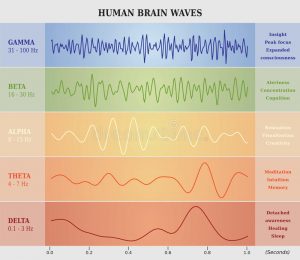Frequency Therapy: Binaural Beats
What are Binaural Beats?
When two somewhat different notes or monoaural waves are played into each ear via earphones or separate speakers, the brain focuses on the difference in those tones as if to cancel the monoaural waves entraining on that resulting beat after the cancellation. The result is called a binaural beat: bi – is audible to both ears; aural – has to do with sound. Thus, this almost inaudible background sound enhances the person in many ways by restructuring brain wave patterns in the brain. Focusing on it is like focusing on the center of the brain. It is sometimes called “digital drug” but it is also referred to as “frequency therapy” or “BB therapy.”
Assuming a 520 Hz monoaural beat enters the left ear, and a 526 Hz monoaural beat enters the right, the 6 Hz difference is the binaural beat. This illustration will give you an idea as to how the two monoaural beats get canceled out by the brain whilst allowing both the ears to focus on the binaural beat. Although we still do not know which part of the brain generates the binaural beat, with the use of common techniques such as electroencephalography (EEG), we can determine the effect of the binaural beat on the mind, including the thoughts, emotions, and of course the corresponding behaviors it elicits.
Brain Waves
To better understand how the brain is affected, we first have to understand a little about brain waves. A brainwave is simply an electrical impulse in the brain that can either be low frequency, high amplitude or high frequency, low amplitude. The brain reacts to external stimuli like sound and sight by creating a brainwave pattern that distinguishes that stimulus from others that it has previously encountered. Brain waves can be divided into functions and include delta waves, theta waves, alpha waves, beta waves, and gamma waves.
- Delta waves are generated during deep meditation, dreamless sleep, or what is called deep stage NREM sleep and healing. In a graph, delta waves are almost a straight line.
- Theta waves are associated with dreams, intuition, meditation, creativity, subconscious thinking, and spatial navigation. In rats, theta waves are generated when they are engaged in motor activities like sniffing. Theta waves are associated with deep sleep or REM sleep.
- Alpha waves, originating from the occipital lobe, are associated with a conscious brain that does calculations when a person is in a relaxed state or is engaged in working memory and the coordination of thoughts.
- Beta waves are also associated with the conscious brain and being attentive to the outside world or when it is engaged in cognitive tasks such as active problem solving, complex and effortful thinking, motor control, high anxiety, excitement, and judgment.
- Gamma waves are brainwaves that have to do with linking information from the different parts of the brain, creating unity of conscious perception, active consciousness, self-awareness, peak cognitive functioning, and spirituality.
Binaural beats stimulate brain waves by the repeated beat and affect the different parts and function of the mind.
How the Brain Processes Sound
Once an auditory input enters the brain, it is believed to first be processed in the superior olivary complex located at the brainstem. This allows us to determine the direction of sound inputs.
When a binaural beat enters the brain, it is tricked into hearing only one beat and responds to that beat by synchronizing the sound. Synchronizing is like having the entire brain adapt to this process. This process of synchronization is called “entrainment.” This makes it possible to create changes in brain wave patterns to synchronize the entire brain to the binaural beat. Regular exposure to binaural beats makes this a normal brain activity and is used to balance overloading in various brain centers, particularly in epileptic patients. This results in strengthening some waves, thus enhancing or suppressing cognitive and emotional functions.
Synchronization
The positive results of binaural beat therapy may be explained via the process of synchronization. When brain waves cannot be processed uniformly, where some parts of the brain receive weaker brain waves, the rest of the brain falls out of sync, and the EEG shows different patterns in brain rhythm. Binaural beats encourage uniformity by modulating oscillations and phase synchronizations on the theory that the brain must treat the beats as one.
Binaural beats not only balance the brain via synchronization. Listening to binaural beats also:
- Reduces anxiety: Mild anxiety, postoperative anxieties, and general anxieties are reduced when theta frequency beats are listened to.
- Enhanced attention: In a study, students diagnosed with ADHD listened to binaural beats for 30 minutes a day. In the first session, attention span improved by 3 minutes. By the end of 3 weeks, the students’ focus greatly improved. The students were exposed to gamma and beta binaural beats.
- Better memory: Alpha binaural beats helped improve working memory capacity. Students who listened to binaural beta beats improved long-term memory. Short-term verbal memory was improved by listening to 15 minutes of theta beats.
- Improves mood and emotional state: It was found that 30 minutes of theta every day decreased tension, confusion, and fatigue. Beta beats helped decrease depression and improve mood.
- Improves creativity: 3 minutes of alpha or gamma beats improved creativity by enhancing divergent thinking – the ability to come up with multiple answers to a problem.
- Helps in pain control: Binaural theta beats reduced chronic pain as recorded in clinical studies.
- Enhances meditation: 30 minutes of binaural theta beats enhanced the attainment of brain patterns achieved in deep meditation.
- Enhances multi-tasking ability: 3 minutes of gamma binaural beats enhanced cognitive flexibility.
- Improves sleep quality: Theta binaural beats improved sleep quality in most subjects.
- Lessens occurrence of migraines: Listening to binaural beats helps reduce the frequency of migraine attacks.
Binaural beats are safe, and they coincide with positive changes in the brain and are easily adapted to the personal needs of the individual. However, binaural beats may temporarily increase depression, anxiety, anger and confusion in some people depending on the aptitude of mind to sounds.
An Alternative Healing Therapy
Binaural Beat Therapy (BBT) is in its infant stage, so studies are still needed to see its full potential as an alternative and non-invasive treatment. For now, it is a complementary therapy to other healing practices, medicinal or otherwise. While some people find binaural beats irritating, most find it to be helpful and effective. It is amazing how binaural beats has spawned an entire industry dedicated to the well-being of people including those that relate to IQ development, relaxation, sleep, meditation, creativity, and healing.
Binaural beats became popular, and some people consider BBT a “digital drug.” It is safe because it is non-invasive and has no adverse physical or psychological effect on the brain. BBT enhances memory, creativity, attention, mood, and healing, as proven in studies. Further studies will establish the potential of therapies depending on the waves and frequencies used. The science of BBT is still very young. Standardization of experiments and therapies including the different waves used need further development. As users of the therapy, we still must consider that each healing method, including BBT, affect each person differently. But there is no harm in trying alternative healing – we just have to find what works best for us.


